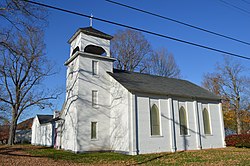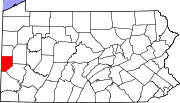Georgetown, Beaver County, Pennsylvania
Georgetown, Pennsylvania | |
|---|---|
 St. Luke's Anglican Church, built 1833 | |
 Location in Beaver County, Pennsylvania | |
| Coordinates: 40°38′28″N 80°30′00″W / 40.64111°N 80.50000°W | |
| Country | United States |
| State | Pennsylvania |
| County | Beaver |
| Settled | 1793 |
| Incorporated | 1850 |
| Government | |
| • Type | Borough Council |
| Area | |
• Total | 0.25 sq mi (0.65 km2) |
| • Land | 0.17 sq mi (0.45 km2) |
| • Water | 0.08 sq mi (0.20 km2) |
| Elevation | 741 ft (226 m) |
| Population | |
• Total | 208 |
| • Density | 1,188.57/sq mi (459.05/km2) |
| Time zone | UTC-5 (Eastern (EST)) |
| • Summer (DST) | UTC-4 (EDT) |
| Zip code | 15043 |
| Area code | 724 |
| FIPS code | 42-28824 |
| GNIS feature ID | 1214876 |
Georgetown is a borough in western Beaver County, Pennsylvania, United States, along the Ohio River. The population was 208 at the 2020 census. It is part of the Pittsburgh metropolitan area. Little Blue Run Lake, the U.S.'s largest coal slurry waste impound, is located next to the town.
History
[edit]
The area of the Ohio headwaters was long inhabited by the Shawnee and several other groups of Native Americans. The first known Europeans to enter the region were French explorers/traders during the 17th century.[3]
Christopher Gist was one of the first English colonists to survey the Ohio River Region around present day Pittsburgh in 1751.[4] George Washington would also survey the area in 1753 as an envoy to demand the French to vacate the territory, which the British had claimed, as land disputes were occurring between British and French colonies at the time.[5][6] Hostilities broke out in 1754 which triggered the French and Indian War.
In 1763, the region became British territory after a War with France. The Province of Pennsylvania gained control of the land through an Indian treaty in 1768.[7]
After the end of the American Revolutionary War in 1783, settlers began to move into western Pennsylvania, Pittsburgh and further west by way of the Ohio River. The area around Georgetown was known to riverboat travelers west of Pittsburgh as a 'last chance' stopping place for food and supplies, before entering into the roughly-charted and dangerous Northwest Territory, (there was an ongoing Indian War in the territory at the time). The closest place of protection was Ft. McIntosh, (in modern-day Beaver), about 20 miles east of the Pennsylvania border line.
The town as it is today was laid out by Benoni Dawson January 13, 1793, and named 'Georgetown'. One theory suggests the name was bestowed in honor of George Dawson, his son. Another theory suggests the town was named in honor of the new U.S. President George Washington, who surveyed the Ohio River area years earlier. Settlement was slow due to hostilities with the Native Americans until General Wayne's Treaty of Greenville in 1795. In 1800, Georgetown would be part of the newly formed Beaver County, surrounded by several townships. The first post office in Georgetown was established in 1802, including its first hotel.[8]
In 1803, in preparation for the Lewis and Clark Expedition, Meriwether Lewis had a keelboat built near Pittsburgh, with plans to sail it down the Ohio River and meet up with William Clark in Kentucky to begin the Expedition. Lewis and his crew stopped at Georgetown to buy a canoe to replace one that was leaky. Lewis later discovered the new canoe also leaked.[9] In 1812 the nearby Mill Creek was used to power mills to grind grain into flour. The first church was built in 1814, St. Luke's Episcopal Church. Georgetown remained a river town for keelboats and later steam boats, until the expansion of railroads and oil drilling after the Civil War.[10]
Geography
[edit]Georgetown is located at 40°38′28″N 80°30′0″W / 40.64111°N 80.50000°W (40.641172, −80.500037).[11]
According to the United States Census Bureau, the borough has a total area of 0.3 square miles (0.78 km2), of which 0.2 square miles (0.52 km2) is land and 0.1 square miles (0.26 km2) (33.33%) is water.
Surrounding and adjacent neighborhoods
[edit]Georgetown has only one land border with Greene Township to the south, east and west. Across the Ohio River to the north, the borough runs adjacent with Glasgow and Ohioville.
Demographics
[edit]| Census | Pop. | Note | %± |
|---|---|---|---|
| 1860 | 295 | — | |
| 1870 | 297 | 0.7% | |
| 1880 | 288 | −3.0% | |
| 1890 | 274 | −4.9% | |
| 1900 | 271 | −1.1% | |
| 1910 | 269 | −0.7% | |
| 1920 | 251 | −6.7% | |
| 1930 | 260 | 3.6% | |
| 1940 | 253 | −2.7% | |
| 1950 | 246 | −2.8% | |
| 1960 | 246 | 0.0% | |
| 1970 | 234 | −4.9% | |
| 1980 | 231 | −1.3% | |
| 1990 | 194 | −16.0% | |
| 2000 | 182 | −6.2% | |
| 2010 | 174 | −4.4% | |
| 2020 | 208 | 19.5% | |
| Sources:[12][13][14][2] | |||
As of the 2000 census,[13] there were 182 people, 67 households, and 52 families residing in the borough. The population density was 1,010.6 inhabitants per square mile (390.2/km2). There were 70 housing units at an average density of 388.7 per square mile (150.1/km2). The racial makeup of the borough was 100.00% White.
There were 67 households, out of which 34.3% had children under the age of 18 living with them, 70.1% were married couples living together, 3.0% had a female householder with no husband present, and 20.9% were non-families. 16.4% of all households were made up of individuals, and 11.9% had someone living alone who was 65 years of age or older. The average household size was 2.72 and the average family size was 3.11.
In the borough, the population was spread out, with 22.0% under the age of 18, 7.7% from 18 to 24, 28.0% from 25 to 44, 25.3% from 45 to 64, and 17.0% who were 65 years of age or older. The median age was 40 years. For every 100 females, there were 122.0 males. For every 100 females age 18 and over, there were 105.8 males.
The median income for a household in the borough was $57,500, and the median income for a family was $59,167. Males had a median income of $38,750 versus $31,528 for females. The per capita income for the borough was $19,838. About 4.0% of families and 3.3% of the population were below the poverty line, including 3.7% of those under the age of eighteen and none of those sixty-five or over.
Industry
[edit]Georgetown is a rural agricultural area, just outside the major steel industries of Pittsburgh. Nevertheless, Georgetown is still close to heavy industry with potential hazards. In the 1970s the Little Blue Run Lake, the country's largest coal slurry waste impoundment, formed as a large artificial lake south-west of Georgetown (on the Pennsylvania and West-Virginia state lines). Because of its large toxic pollution content, the facilities closed down in 2016.[15]
Georgetown is a couple miles downstream from old J & L steel mills and other metal facilities such as ATI Allegheny Ludlum, Marathon Petroleum and the Beaver Valley Nuclear Power Plant.
Education
[edit]Children in Georgetown are served by the South Side Area School District. The current schools serving Georgetown are:
- South Side Elementary School – grades K–5
- South Side Middle School – grades 6–8
- South Side High School – grades 9–12
See also
[edit]References
[edit]- ^ "ArcGIS REST Services Directory". United States Census Bureau. Retrieved October 12, 2022.
- ^ a b "Census Population API". United States Census Bureau. Retrieved October 12, 2022.
- ^ Solon J. Buck, Elizabeth Buck, The Planting of Civilization in Western Pennsylvania, 1976.
- ^ William M. Darlington (ed.). Christopher Gist's Journals, with Historical, Geographical and Ethnological Notes and Biographies of His Contemporaries, Pittsburgh, J. R. Weldin & Co., 1893; Part 4: 1750-51.
- ^ "Washington as Public Land Surveyor | George Washington: Surveyor and Mapmaker | Articles and Essays | George Washington Papers | Digital Collections | Library of Congress". Library of Congress.
- ^ McCain, George Nox., Lambing, Andrew Arnold., White, John W. F.. Allegheny County: Its Early History and Subsequent Development from the Earliest Period Till 1790. Snowden & Peterson, 1888.
- ^ Billington, Ray A. "The Fort Stanwix Treaty of 1768," New York History (1944), 25#2 pp. 182–194.
- ^ History of Beaver County, PA. http://www.beavercountypa.gov/Pages/History.aspx
- ^ Green Township - History of Georgetown. https://greenetownship.net/history/georgetown/
- ^ Francis W. Nash. Georgetown Steamboats. It used to be a River Town (2009). http://georgetownsteamboats.com/gs/georgetown-pa/
- ^ "US Gazetteer files: 2010, 2000, and 1990". United States Census Bureau. February 12, 2011. Retrieved April 23, 2011.
- ^ "Census of Population and Housing". U.S. Census Bureau. Retrieved December 11, 2013.
- ^ a b "U.S. Census website". United States Census Bureau. Retrieved January 31, 2008.
- ^ "Incorporated Places and Minor Civil Divisions Datasets: Subcounty Resident Population Estimates: April 1, 2010 to July 1, 2012". Population Estimates. U.S. Census Bureau. Archived from the original on June 11, 2013. Retrieved December 11, 2013.
- ^ Hopey, Don (April 3, 2014). "Little Blue Run coal ash site to close sooner; Plant owner must contain pollution". Pittsburgh Post-Gazette. Retrieved April 2, 2015.



